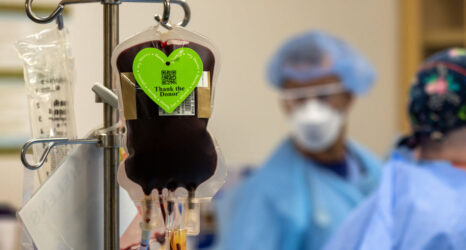Today marks the one year anniversary of Whole Woman’s Health v. Hellerstedt—the landmark court case that repealed HB2, an omnibus abortion bill in Texas.
HB2 was a TRAP law—standing for Targeted Restrictions on Abortion Providers—that was meant to chip away at abortion access by imposing arbitrary and extraneous regulations on abortion providers and clinics that have no bearing on the safety and well-being of patients. Like many other TRAP laws, it worked: Clinics shut their doors, and others that hadn’t became overwhelmed by the volume of patients redirected from those that had. Women across Texas lost access to abortion. Low-income women and women of color along the Rio Grande Valley were hit hardest.
Candice Russell, a writer and activist from Texas, sought abortion care under HB2. When faced with the prospect of having to wait up to three weeks to schedule an initial appointment—a commonality under TRAP laws due to clinic closures—and a mandated 24-hour waiting period in between appointments, Russell was left with no option but to leave the state. She took out a high interest loan, took time off of work and made her way to California to access abortion care.
Russell’s story was part of the amicus brief sent to the Supreme Court when Whole Woman’s Health was underway. She spoke with Ms. about her experience and how we can keep fighting in the wake of the Hellerstedt decision.
You’ve been open about the fact that you have received two different abortions. Can you speak a little about how those experiences were different?
I had my first abortion in Seattle under vastly different circumstances. I grew up in a very liberal area and I was 20 at the time and I was dating the man who would eventually become my husband. But we had only been dating for a very short time and when I realized I was pregnant, it was very easy for me to get an appointment. I was able to be open about it with pretty much everyone I knew. Everyone was super supportive.
After I moved to Texas in 2009, it was kind of an awakening. I had been very privileged to grow up where I did and unfortunately that wasn’t where I lived anymore. And so when all the HB2 actions started happening in Austin, the way abortion was being talked about was different. It was so easy for me to talk about the abortion I had when I was 20. I was poor and unmarried and in a liberal area so people could be sympathetic to my circumstance.
However, I realized I was quiet after going to California to have my second abortion. This time, I was 30 years old and I was more financially stable and even I understood that was not going to be something that people would take as lightly. So even though I was out there talking about my abortion and involved in reproductive justice I was very quiet.
At what point did you decide to become open about your second abortion?
I realized my silence was doing both my personal experience and the work I was doing a disservice. I was acting like one of my abortions was not as valid as the other. And I was also being silent about the very real consequences of HB2. Initially, I didn’t want to have to deal with people judging me for how old I was, or feel like I had to explain that I was on birth control. As the anniversary of state Senator Wendy Davis’ filibuster for HB2 came around, I realized I was feeding into the stigma of some abortions being more acceptable than others. I wasn’t letting people know what HB2 was doing to actual Texas residents. I realized I wasn’t doing myself or my state any favors and decided I was going to talk about both of my abortions because they were both equally important.
How was your story about your second abortion received compared to the first one?
There was certainly some blow-back. There’s a big section of my family that doesn’t talk to me anymore because of the work that I do. I was fired from my last job for speaking out. People were sending me hateful messages online. But I soon realized that the better you are at what you do, the louder the opposition will get. I found strength in the community I had built and mentors who supported me.
What have you found to be the most effective way of expanding people’s perspectives on abortion rights?
I think the conversation around abortion is shifting and I really think abortion storytelling is a huge piece of that. Over the course of the past three and a half years, I found that the best thing that I could do was be vocal about my story. Everybody loves somebody who’s had an abortion regardless of whether or not they know that. I think that for too long, there’s been this stigma surrounding what abortion looks like—even on the left. I think one of the reasons that we were able to turn that around with Whole Woman’s Health was because there were so many people out there talking about their real lived experiences—talking about how these laws affect actual human beings.
How should we celebrate Whole Woman’s Health while acknowledging that the fight for reproductive justice is an ongoing battle?
I think the most important thing is that the conversation around abortion is shifting. People have been making art pieces, theatre pieces, podcasts, and anthologies about different people’s experiences with reproductive health. For me, the biggest realization from Whole Woman’s Health is that my voice shouldn’t be the only one out there. There are so many women’s stories that are not being validated and they are being forced to become parents when they know it is not right for them. There is often the misperception that women who receive abortions are selfish, when in fact they are making a selfless decision not to bring a child into a world where they cannot be cared for in the ways they deserve. One in three women receive an abortion. Therefore, their stories must be more nuanced than the way stigma surrounding abortion allows them to be.
In 1972, Ms. made history by publishing “We Have Had Abortions,” an open letter and petition for abortion access signed by 53 women—including Gloria Steinem, Nora Ephron, Grace Paley, Susan Sontag and Billie Jean King—who had abortions before the practice was legal. We invited readers and public figures alike to join us in signing on to the petition, demanding from lawmakers a “repeal of all laws that restrict our reproductive freedom.” On the anniversary of the decision in Hellerstedt, Ms. honors the bravery of women who share their abortion stories, reproductive health providers and activists nationwide who have continued the fight for women’s bodily autonomy and reproductive rights.





